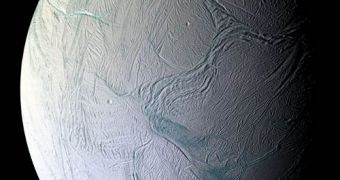The moons of Saturn are undoubtedly some of the most peculiar space objects in the solar system. More specifically, Titan and Enceladus take the spotlight when it comes to unusual phenomena that happen on their surface. Enceladus is covered by a thick ice crust, which releases blobs of warmer ice than that on its surface from time to time. This hints at a heat source within the object, but the origins of such a source have always remained a mystery.
Now, using data from the NASA/ESA Cassini spacecraft in orbit around the gas giant, researchers at the University of California in Santa Cruz (UCSC) have managed to get more info on the bizarre moon. No less than four years ago, the space probe captured an amazing phenomenon taking place at Enceladus' south pole. The spacecraft imaged the moon just as it was releasing a heat flow that was estimated to be roughly equal to six gigawatts of energy. This is the equivalent of roughly 12 electric power plants back on Earth, or about three times the maximum amount of energy any given surface of comparable size on our planet can produce naturally.
Additionally, other Cassini data also showed that the same southern regions released at one point large amounts of the chemical element argon, in its gas form nonetheless. Usually, this element comes from the radioactive decay of rock, and chemists are very well acquainted with its decay rate. Therefore, they were able to predict that the rate at which Enceladus produced heat and gas was unsustainable, and that the Saturnine moon would not be able to maintain this production process for long periods of time. Moreover, the crust covering the south pole was found to be between 500,000 and one million years old, which is very young compared with the 4.2 billion years the northern crust has.
According to a computer model, this may be owed to a cyclical, churning cycle affecting Enceladus. One such cycle may last for as much as ten million years, before calmer periods, of between 100 million to two billion years ensue. “These tumultuous periods are rare and Cassini happens to have been watching the moon during one of these special epochs,” UCSC planetary scientist and researcher Francis Nimmo told Space. “It's not a coincidence this is happening at the south pole of Enceladus. If you have hot blobs of rising ice, that will actually help tilt the satellite over,” he added.
Details of the investigation appear in a new scientific paper, published in the January 10 issue of the esteemed scientific journal Nature Geoscience. “If the argon was continuously coming out, it would all be used up in a few tens of millions of years, but it only comes out every so often, switching off and building up and then coming out again,” Nimmo concluded.

 14 DAY TRIAL //
14 DAY TRIAL //